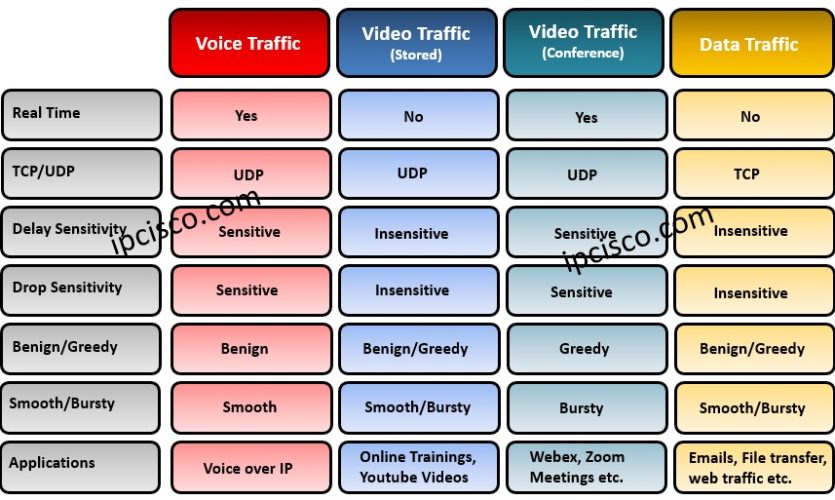- COURSES
- SPECIALS
- BLOG
- MEMBERS
- SHOP
- ABOUT
- ENROLL HERE

There are different network traffic types in a network. These traffic types have different characteristics and requirements. So, in a network there are different behavior according to the traffic types. We achieve this with Quality of Service (QoS) configurations. So, what are these network traffic types? These are basically three types of traffic: voice, video and data traffic.
Now, let’s focus on each of these traffic types and learn what they need or what are the best behavior for these types of traffics.
Table of Contents
Voice traffic is a real time and sensitive traffic type. The voice packets must be delivered at the same time or with a very low delay. Because, if the voice packets arrive in different types to the destination, we can not understand what they are saying. So, delay time is very important for such a traffic.
Beside variable delays cause jitter and jitter is a wellknown problem for voice traffics. To have a clear voice at the other end, jitter must be avoided.
The last important problem is packet loss for voice traffic. We can tolerate some loss but this must not be a high value that will make the communication incomprehensible.
To avoid delay, jitter and packet loss we use Quality of Service (QoS) configuration on routers. With these configurations, we avoid any problem on voice packets and we prioritize this type of traffic. Voice packets needs higher priorities over other network traffic types. Because, this type of traffic is the most sensitive traffic.
In voice traffic, generally UDP (User Datagram Protocol) is used because of its fast behavior.
Video traffic is one of the most used traffic types in today’s world. With the increase of the youtube watching times, online training and similar traffics, video became very important as a traffic type. Video traffic is a high volume traffic that is not as sensitive as voice traffic. Because video traffic is not real time generally. It can tolerate packet loss and delays. And delay on the packets do not cause any misunderstanding. It causes only a little extra time. Beside any loss can be tolerated because it is a very high volume traffic and if we loss small amount of this traffic, the video can be still understandable and clear.
There is also another video type that is used in real time. Videoconferencing traffic can be an example of this type of traffic. In this type of traffic, delays became more important because we are in the real time and we do not have too much extra time for a face to face conference call. A person is talking and waiting other person’s talking. This type of communication can not be achieved with higher delays.
Because of its volume, video traffic can be bursty and can consume many resources of your network. So, for such traffic, your network and bandwidth must be ready.
For video traffic UDP (User Datagram Protocol) is used again because this type of traffic is also delay sensitive traffic.
Data traffic is the other important traffic type. This type of network traffic is insensitive traffic to packet loss if we compare with voice and video traffic. It uses retransmission mechanism if any packet loss occurs.
This type of traffic is used in emails, file transfers, web pages etc. So, guarantee is an important term for such a network traffic. To provide secure and guaranteed transfer, TCP is used with data traffic. The restransmission mechanism of TCP gives this guarantee and data traffic is sent with a minimum loss.
Again, delay is not too important for this type of traffic. For example, if any delay occurs, you receive an email a little lately that we can measure it with seconds.
We have talked about these traffic detailly above. Below, you can find comparison table for voice traffic, video traffic and data traffic.
In Cisco CCNA Exam and CCNP ENCOR Certification Exams, you can see questions about these types of traffic.
Leave a Reply